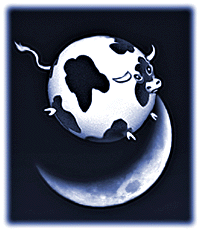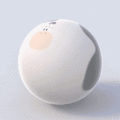Spherical cow facts for kids

A spherical cow is a funny idea used in science. It's a way to talk about how scientists sometimes make a complicated problem much simpler so they can solve it. Imagine a real cow with all its bumps and fur. Now imagine a perfectly smooth, round cow. That's a spherical cow! It's not real, but it helps explain a big idea.
This idea helps scientists focus on the most important parts of a problem. They ignore the small, tricky details at first. This makes it easier to understand the main idea.
The Funny Story Behind It
The idea of a "spherical cow" comes from a funny joke. A farmer was having trouble getting enough milk from his cows. He asked a smart scientist, a theoretical physicist, for help. The farmer wanted to know how to get more milk and make more money.
The physicist went away to think about the problem. Later, he came back to explain his solution at a meeting. He started by saying, "First, let's pretend the cow is a perfect sphere..." Everyone laughed because it sounds silly! But it shows how scientists sometimes simplify things to find an answer.
Why Scientists Simplify Problems
Scientists often face very complex problems. Think about predicting the weather or how a rocket flies. There are so many tiny details! If they tried to include every single detail, it would be too hard to figure out.
So, they create a "model." A model is a simpler version of something real. For example, when studying how a ball falls, a scientist might first ignore air resistance. This makes the math much easier. Once they understand the basic idea, they can add back the more complex parts, like air resistance, later. The spherical cow is a funny way to remember this important step in science.
Sometimes, people use a "spherical horse" instead of a cow. There's another joke about a physicist who says he can figure out who will win a horse race. But first, he needs to imagine a "spherical horse moving through a vacuum" (which means no air). Again, it's a silly idea, but it makes the point about simplifying things to solve a problem.
Images for kids
-
A GIF of a spherical cow.
-
A drawing of a spherical cow on skis, with the text Approksimoidaan pyöreä lehmä (Finnish for "We approximate a spherical cow").
See also
 In Spanish: Vaca esférica para niños
In Spanish: Vaca esférica para niños



